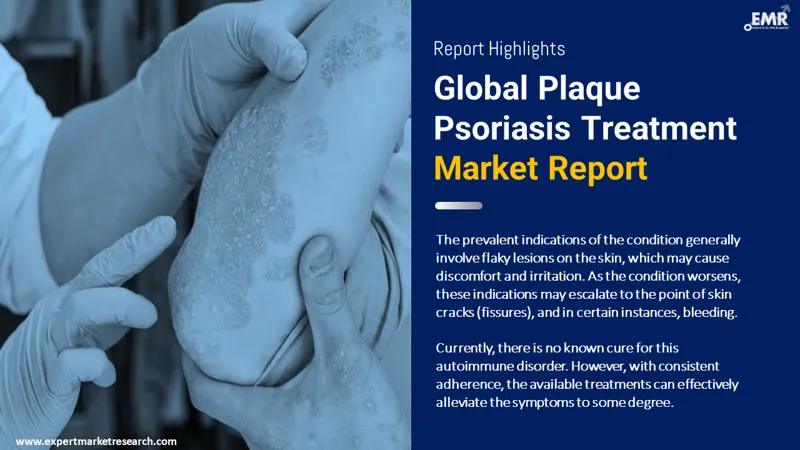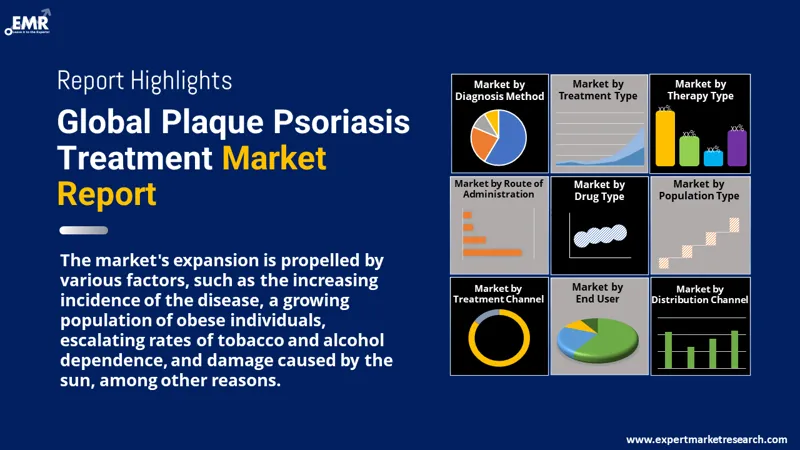
Consumer Insights
Uncover trends and behaviors shaping consumer choices today
Procurement Insights
Optimize your sourcing strategy with key market data
Industry Stats
Stay ahead with the latest trends and market analysis.
The growth of the global plaque psoriasis treatment market size is being driven by the rising prevalence of the condition across the globe. The number of worldwide cases in 2025 was close to 132.50 Million. The prevalence of the condition is anticipated to grow at a CAGR of 3.00% during the forecast period of 2026-2035, likely to reach 178.07 Million cases by 2035.
Base Year
Historical Period
Forecast Period
Compound Annual Growth Rate
3%
Value in Million
2026-2035
*this image is indicative*
Psoriasis refers to a skin condition which leads to red, inflamed, raised, and itchy skin on different parts of the body. The condition has various types and plaque psoriasis is one of the most common types, affecting more than 8 million Americans every year. About 90% of psoriasis patients suffer from plaque psoriasis, making it the most prevalent type of the condition. Plaque psoriasis is an auto-immune chronic disorder in which the production of new skin cells becomes extremely fast. While the production of new skin cells normally takes place in 28-30 days, the production speeds up and the new skin cells start developing within 3 to 4 days. The replacement of old skin cells with new ones results in the production of plaques over the skin. The increased prevalence of the condition is providing significant impetus to the growth of the plaque psoriasis treatment market.

Read more about this report - REQUEST FREE SAMPLE COPY IN PDF
Plaque psoriasis leads to severe red patches or plaques all over the skin, with thick whitish scales which are made of dead skin cells. These scales can occur throughout the body and/or on parts of the body which are mostly dehydrated, like scalp, elbows, lower back, knees, among others. Patients with severe condition also experience these scales on their face, feet, hands, legs, and even genitals, if not controlled timely. These patches are extremely problematic since it causes severe itchiness and even hurts, and the burning sensation can become intense and worse with time. It even becomes difficult for the patient to wear clothes over these patches, leading to perennial discomfort.
As discussed above, the most common symptoms of the condition mostly include scaly patches on the skin, which can painful and irritating. As the condition aggravates, the symptoms can intensify to crack (fissures) in skin and even bleeding in some cases.
The auto-immune disorder does not have a cure yet, but the available treatments are effective and can help relieve the symptoms to some extent, if followed regularly. The exact cause of the disease is not known yet, but genetic factors and immune system play a pivotal role in the development of this condition. Other diseases like Crohn's disease, fatty liver disease, diabetes, and metabolic syndrome can also lead to this skin condition.
Plaque psoriasis mostly happens due to genetic factors, it usually runs in the family. This skin condition can happen to anyone, irrespective of their age or sex, however, if affects some more than the others. People belonging to western regions are more vulnerable to this condition than the others.
The possibility of suffering from plaque psoriasis is also significantly dependent on the lifestyle of an individual. Consumption of alcohol, smoke, and other tobacco-based products can increase the chances of suffering from this disorder. Moreover, being obese can also increase a person’s vulnerability to the condition. Having depression or stress can also worsen this condition, since that mostly leads to the irregularity in the consumption of medicines and lack of self-care. The condition can also be caused due to triggers like reaction of some medicines or severe sunburn.

Read more about this report - REQUEST FREE SAMPLE COPY IN PDF
The market can be categorised into diagnosis method, treatment type, therapy type, route of administration, drug type, population type, treatment channel, end user, distribution channel, and major regions.
Market Breakup by Diagnosis Method
Market Breakup by Treatment Type
Market Breakup by Therapy Type
Market Breakup by Route of Administration
Market Breakup by Drug Type
Market Breakup by Population Type
Market Breakup by Treatment Channel
Market Breakup by End User
Market Breakup by Distribution Channel
Market Breakup by Region
The treatments currently available in the plaque psoriasis treatment market can only help in relieving and controlling the symptoms and do not guarantee complete cure from the disease. These treatments must be regularly followed to be effective. If the patient does not follow the regime regularly, then it might not help in managing the symptoms.
While these treatments can help relieve the symptoms, it is always better to follow preventive measures to avoid worsening the condition further. The patients can practise a healthy diet and regular skin care regime to avoid further damage, along with regular consultation with their doctors.
The demand for the treatment market is rapidly rising with the rising number of cases across the globe. Changing lifestyles of people, along with the rising addiction to tobacco-based products, cigarettes, and alcohol, has increased their risk of suffering from this condition. Rising number of obese people is also contributing to the rising prevalence of the disease, especially in North America.
North America is leading the global market with a significant share. While in the developing region, the awareness about the condition is pretty low, developed regions are taking initiatives to boost the awareness about the condition. For instance, August is celebrated as Psoriasis Awareness Month in the United States every year. During this month, the government aims to provide support to those who are affected by this condition and spread awareness about the condition. Such initiatives are leading to higher people opting for diagnosis when they experience any symptom similar symptoms, which results in early detection and timely treatment.
Apart from North America, Europe is also witnessing higher growth due to the rising prevalence of the disease. In the Asia Pacific region, leading countries like Australia and India are also witnessing fast growth due to the rising awareness about the condition and its treatment, aided by government support. Such measures are significantly aiding the growth of the market.
The major companies working on the drugs and treatment of the condition and investing in the clinical trials include the following:




*While we strive to always give you current and accurate information, the numbers depicted on the website are indicative and may differ from the actual numbers in the main report. At Expert Market Research, we aim to bring you the latest insights and trends in the market. Using our analyses and forecasts, stakeholders can understand the market dynamics, navigate challenges, and capitalize on opportunities to make data-driven strategic decisions.*
Get in touch with us for a customized solution tailored to your unique requirements and save upto 35%!
The number of plaque psoriasis cases was close to 132.50 Million in 2025.
The prevalence of the condition is likely to grow at a CAGR of 3.00% during the forecast period of 2026-2035. The number of cases are likely to reach close to 178.07 Million by 2035.
The growth of the market is driven by the rising prevalence of the disease, rising population of obese people, growing addiction to cigarettes and alcohol, and sun damage, among others.
The rising awareness about the condition, along with the readily available treatments, acts as key trends for the market.
The diagnosis methods can be categorised into blood tests, skin prick test, patch test, and biopsy, among others.
The condition is treated with biological drugs, systemic drugs, and topical drugs. Apart from drugs, phototherapy is also used to treat the patches.
The therapy types used for plaque psoriasis include monotherapy and combination therapy.
The routes of administration include oral, parentals, and topicals, among others.
The population type can be categorised into children, adults, and geriatrics.
The treatment channels in the market include private and public channels.
The end-user segments include hospitals, specialty clinics, and homecare settings, among others.
The distribution channels in the market include hospital pharmacy, retail pharmacy, and online pharmacy, among others.
The major regions in the market are North America, Latin America, the Middle East and Africa, Europe, and the Asia Pacific.
The key players in the market include Pfizer Inc., Abbvie Inc., Novartis AG, Amgen Inc., Boehringer Ingelheim International GmbH., Merck & Co Inc., Sun Pharmaceutical Industries Ltd., Teva Pharmaceuticals Industries Ltd., AstraZeneca, Ampio Pharmaceuticals Inc., Eli Lilly and Company, Novartis International AG, Sun Pharmaceuticals Industries Ltd., Stiefel Laboratories, UCB S.A., LEO Pharma, Cipla Inc., Rowan Bioceuticals, Win-Medicare Pvt. Ltd., Sanofi S.A., and Glenmark Pharmaceuticals.
Explore our key highlights of the report and gain a concise overview of key findings, trends, and actionable insights that will empower your strategic decisions.
| REPORT FEATURES | DETAILS |
| Base Year | 2025 |
| Historical Period | 2019-2025 |
| Forecast Period | 2026-2035 |
| Scope of the Report |
Historical and Forecast Trends, Industry Drivers and Constraints, Historical and Forecast Market Analysis by Segment:
|
| Breakup by Diagnosis Method |
|
| Breakup by Treatment Type |
|
| Breakup by Therapy Type |
|
| Breakup by Route of Administration |
|
| Breakup by Drug Type |
|
| Breakup by Population Type |
|
| Breakup by Treatment Channel |
|
| Breakup by End User |
|
| Breakup by Distribution Channel |
|
| Breakup by Region |
|
| Market Dynamics |
|
| Supplier Landscape |
|
| Companies Covered |
|
Datasheet
One User
USD 3,299
USD 2,969
tax inclusive*
Single User License
One User
USD 5,499
USD 4,949
tax inclusive*
Five User License
Five User
USD 6,999
USD 5,949
tax inclusive*
Corporate License
Unlimited Users
USD 8,199
USD 6,969
tax inclusive*
*Please note that the prices mentioned below are starting prices for each bundle type. Kindly contact our team for further details.*
Flash Bundle
Small Business Bundle
Growth Bundle
Enterprise Bundle
*Please note that the prices mentioned below are starting prices for each bundle type. Kindly contact our team for further details.*
Flash Bundle
Number of Reports: 3
20%
tax inclusive*
Small Business Bundle
Number of Reports: 5
25%
tax inclusive*
Growth Bundle
Number of Reports: 8
30%
tax inclusive*
Enterprise Bundle
Number of Reports: 10
35%
tax inclusive*
How To Order

Select License Type
Choose the right license for your needs and access rights.

Click on ‘Buy Now’
Add the report to your cart with one click and proceed to register.

Select Mode of Payment
Choose a payment option for a secure checkout. You will be redirected accordingly.
Gain insights to stay ahead and seize opportunities.

Get insights & trends for a competitive edge.

Track prices with detailed trend reports.

Analyse trade data for supply chain insights.

Leverage cost reports for smart savings

Enhance supply chain with partnerships.

Connect For More Information
Our expert team of analysts will offer full support and resolve any queries regarding the report, before and after the purchase.
Our expert team of analysts will offer full support and resolve any queries regarding the report, before and after the purchase.
We employ meticulous research methods, blending advanced analytics and expert insights to deliver accurate, actionable industry intelligence, staying ahead of competitors.
Our skilled analysts offer unparalleled competitive advantage with detailed insights on current and emerging markets, ensuring your strategic edge.
We offer an in-depth yet simplified presentation of industry insights and analysis to meet your specific requirements effectively.
Share